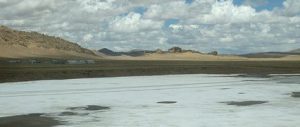Andreas Schild is director general of the International Centre for Integrated Mountain Development (ICIMOD), based in Kathmandu, Nepal. ICIMOD works to develop an economically and environmentally sound mountain ecosystem to improve the living standards of high-altitude populations in the Hindu Kush-Himalayas and to sustain vital ecosystem services for the billions of people living downstream. A development specialist, Schild is to speak on August 31 at the “Kathmandu to Copenhagen 2009” conference, which focuses on South Asian countries’ vulnerabilities to climate change and aims to catalyse a common Himalayan response. Isabel Hilton, editor of chinadialogue, spoke to him before the conference.
Isabel Hilton (IH): Since the last IPCC report – the Fourth Assessment Report of the Intergovernmental Panel on Climate Change — many scientists have said that climate change is moving faster than was reflected by that assessment. Is this your observation with respect to the “third pole” — the Himalaya and the Tibetan plateau?
Andreas Schild (AS): We cannot confirm this statement and the main reason is that we do not have directly available reliable and consistent data. This is also the reason why the IPCC Fourth Assessment hardly mentions the Hindu Kush-Himalayan region. We are presently involved in a review of the situation of the glaciers and we can confirm that the retreat of glaciers, which has already been reported, is taking place and is accelerating.
However, we hesitate to make such a statement, because we have to see what kind of glacier we are speaking about. We also have to be aware that certain glaciers — large glaciers in the Karakorum, for instance — are growing. But even this statement tends to create misunderstandings: the growing is probably due to changing precipitation patterns, perhaps more precipitation in the winter season due to westerly winds. But this is an intelligent guess, which for the time being cannot be supported by science. Glaciers, which depend on the monsoon in the western Himalayas, tend to be receding quicker.
Glaciers are excellent indicators because change is immediately visible and understandable for the layman. But addressing the changing precipitation patterns of the monsoon and changing biodiversity require much more refined monitoring tools. The bottom line is that for the Hindu Kush-Himalayan region, we do not have reliable data and we do not have the monitoring instruments in place to make clear statements.
IH: Is it possible to detail the projected impacts on regional downstream countries? Do you see any connection, for instance, between the retreat of the glaciers and such phenomena as the failure of the Indian monsoon this year, or the floods and typhoons in China and Taiwan, or are these coincidental phenomena?
AS: It is very dangerous to take punctual, one-time events and interpret them for the explanation of a global phenomenon. We need multi-annual data chains and have to apply modelling techniques, which indicate certain trends. To refer to isolated events and interpret them directly is very risky. Studies of such major events as floods in South Asia since the 1960s tend to indicate that they are the product of locally isolated outbursts, which as typical for mountain systems. The trend is that they are recurring more frequently and with greater amplitude.
IH: What do we know and how do we know it? It is a vast and varied region, but in some respects it is one huge ecosystem fragmented across several countries. How important is it to reach a comprehensive scientific understanding of the region scientifically, and is that possible?
AS: We have to accept that within the Hindu Kush-Himalayan region there are great variations. In mountains, we have to accept that there are very local and rapidly changing extreme situations and events. From this point of view, it is not possible to make sweeping statements for the whole region. However, what is possible is to make longitudinal and latitudinal transects, which allow observations and conclusions for sub-regions, water basins or specific systems. ICIMOD is working on such a concept with the regional partners and finds an encouraging interest among the specialists.
In order to become relevant, this needs firm and long-term commitment from the governments. At this point, we have to define relevant sub-regions where comprehensive statements can be made. Political borders do not usually define these: they are transboundary and cross political borders. I am referring here to river basins, to landscape corridors and so on.
The difficulties are that, in the past, data gathering and interpretation has been done on an ad hoc basis, project-wise and without continuity. The governments have not given priority to such phenomena. The consequences are a high presence of external actors, such as universities, which do a lot of research but do not necessarily coordinate. Another difficulty is the different level of capacity of the institutions, which does not facilitate the exchange of information, and a lot of data are not exchanged because of institutional, political and personal reasons.
IH: What role does satellite monitoring play in advancing our understanding of what is happening? Is it enough?
AS: Remote sensing instruments and satellite imagery is very useful indeed and is making quick progress. Such instruments are very useful for the indication of trends and for general interpretations. In practice, though, these instruments have to be accompanied with in situ investigation and observation. Modelling based exclusively on remote sensing has too great a variability compared with field observation.
For example, we have a fairly good view of the growth and retreat of glaciers and glacial lakes based on remote sensing. However, we cannot estimate reliably the quantity of ice available, the mass balance and the evolution of the ice quantity. This is highly relevant to estimates of the water stored in the form of ice, and water availability during dry season for irrigation. Even more critical is the assessment of permafrost through remote sensing. Such observations are of great importance in order to assess such disaster risks as moraine breaks and landslides.
IH: How would you assess the region’s readiness in terms of awareness of the impacts, adaptation and mitigation strategies?
AS: It is very difficult to answer a question that encompasses so many countries and the substantial differences between awareness, adaptation and mitigation. We can safely say that the awareness of the consequences of climate change has substantially increased. Some regional countries make a substantial effort. However, their positions depend greatly on the prevailing situation in the respective countries.
There are extreme cases in the region, such as Afghanistan, Nepal and Myanmar. All the three have very specific internal agendas and priorities. Nepal is an extreme case because it is potentially a main loser and winner at the same time. However, climate change is very low on the political agenda.
In the conference at the end of August — which is exclusively donor-driven by the World Bank, DfID [the UK Department for International Development] and Denmark — the interest is mainly in how much participants can get through the carbon trade facilities. At the other extreme is Bhutan, which is branding itself as a green, environmentally conscious country. India and China are doing a lot in terms of adaptation and are very active. The same can be said of Pakistan, which is extremely worried because of the consequences for food security. Bangladesh can make important investments thanks to donors like DfID.
Mitigation is a completely different chapter and cannot be answered in a professional way in this context. The difficulty for the big regional countries is that mitigation is directly linked with growth. From the mountain perspective, ICIMOD is focusing clearly on adaptation. The global debate on mitigation will only have long-term effects. In the meantime, it is essential to strengthen adaptation and build resilient communities. Practically, this means that the adaptation agenda has to be linked closely to other agendas. Poverty is the overriding issue; for mountain communities, globalisation, migration and isolation also are concerns.
Mountains are largely suffering from climate change and are not the polluters. On the other hand, they have not benefited from the carbon-trading facilities. The global architecture, data availability and transaction costs do not favour them. We fear their potential will also be limited in the future. This could have dramatic consequences. Mountains are very sensitive systems and are fragile. The ecosystem services in terms of water, biodiversity, cultural heritage, space for recovery, tourism and so on will be affected. This will influence food security, particularly in Asia, where the main rivers are highly dependent on mountain and snow and ice discharge.
IH: What are the risks of lack of preparedness?
AS: Again, a very difficult question. Talking of preparedness, let’s look at disaster preparedness. Most dangers are not new; local communities have learned to adapt to new risks and have developed a substantial amount of resilience. They continue to learn. Most critical is the arrival of change due to external actors. Very often schoolhouses are built on marginal land or in very exposed situations. The same holds true for health posts. Thanks to the availability of soft money in poverty alleviation funds, some of the most popular investments are access roads. Because they are built ignoring all principles of engineering, new vulnerabilities due to climate change are created. The effect on water, biodiversity, required land cover and land use are rather slow processes.
The most immediate risk of lacking preparedness is the loss of life and assets. To ignore the risks is to create prospective loss and the destruction of investment goods. The higher the investments, the more relevant knowledge is, rather than preparedness. High investments require a good knowledge of risks that originate in climate change and the prospective investment.
For example, on the Tama Kosi, a river in the Kosi system, hydropower stations for an installed capacity of 938 megawatts are planned. Upstream, on the Chinese side, 40 potentially dangerous glacial lakes are identified. The planners have no long-term data of the water flow and have to plan to protect these investments from undue and incalculable risks. The planners must include so many safety measures to protect the investments that either the investment costs or the risks are very high. The lack of knowledge is therefore making it difficult to take well-informed decisions, which implies the danger of promoting unproductive investments.
IH: In what areas do we need greater cooperation?
AS: First of all, we should close the knowledge gaps. This means making knowledge and data that basically exists available and accessible. Then we need institutions and mechanisms to build up knowledge banks and monitoring facilities. This means institution-building, which is highly unpopular among the donors, and increased research capacity in local specialised institutions and universities. The third important element is the promotion of the transboundary exchange of information and co-operation. Fourthly, the donors: the traditional development agencies have made a lot of progress, at least verbally, in donor coordination, basket funding [joint funding by several donors] and national ownership.
On the other hand, we realise that within the frame of globalisation, traditional donor countries have created new instruments of international cooperation. In a globalised world, there are no external politics, just global interior politics — so technical ministries have received funds to cooperate with stakeholders around the world. Climate change means that for one specific country, different actors make contributions, cooperate and do research without any substantial coordination capacity within the respective country. Climate change is creating new channels of cooperation, without clear coordination and consultation mechanisms.
From ICIMOD’s point of view, we think more information and awareness has to be created in what in the west is called civil society. Knowledge has to be increased among multipliers to be able to influence the political agenda. Such information should definitely illuminate the dangers and risks, and at the same time create new opportunities, particularly for mountain countries.
IH: How can this situation be improved?
AS: Probably the single most important element in the countries, but also for the donors, is the commitment to more long-term objectives — for continuity, which also implies awareness creation and institution building. I think another very important element is the promotion of development potential in the countries themselves and being aware that there are other important agenda points as well as climate change.
IH: What are the risks of failure to achieve cooperation?
AS: The risks are increased vulnerabilities, less-than-optimal allocation of resources and increasing development gaps.
Andreas Schild is director general of the International Centre for Integrated Mountain Development (ICIMOD).
Isabel Hilton is editor of chinadialogue
Homepage image by Charles Masters



